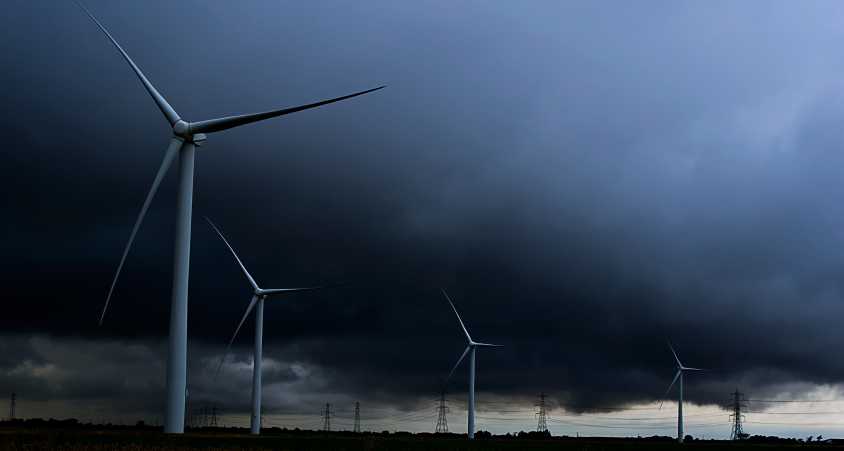How resilient is renewable electricity generation?
Europe is expanding renewable electricity at a slow but steady pace. If we want to become independent of fossil fuels and nuclear power, these new electricity sources must be reliable, also in the face of weather extremes and a changing climate.
The recent assessment report of the Intergovernmental Panel on Climate Change (IPCC) shows that switching from fossil to renewable energy sources is beneficial for mitigating climate change, but as a single measure far from being sufficient. The IPCC warns that weather extremes such as floods, storms and droughts will likely be stronger and more frequent in the future if global warming continues. Reason enough to consider the resilience of our energy sources in the face of the extreme weather events we are experiencing already and might experience more frequently and in greater strength in the future.
Regularly, summer droughts and heat waves force large thermal power stations - that produce the majority of our electricity today - across Europe to temporarily shut down due to problems with their cooling systems. Especially the heat waves of 2003, 2006 and 2009 forced numerous nuclear reactors offline, so that parts of the power system nearly – but only nearly – broke down. The interconnected European power system makes it resilient: one or a few large power stations may be forced offline by extreme weather, but the huge European system has so far always had sufficient back-up capacity to buffer the loss and avoid blackouts.
But how will the decarbonized energy system we strive for, one that relies mostly on renewable energy sources, fare in the face of extreme conditions?
A grid for more resilience
Wind and solar power generators are completely different than coal and nuclear power. As they draw their energy directly from the sun or the wind, they are directly exposed to weather extremes, such as hail or wind storms. We know from past weather extremes that thanks to technological advances modern wind and photovoltaic (PV) power units are very robust and will survive most events. Yet, if extreme weather becomes more violent, this could be a problem for single renewable generators.
An entire system based on wind and solar power, however, is likely to be even less vulnerable to weather extremes than a thermal-based (conventional) electricity system. There are three main reasons for this.
First, PV and wind power are not thermal technologies and will not be severely affected by events that could, in principle, affect thermal power stations such as droughts, floods or increasing air temperatures. What may affect them are future changes in cloud cover and wind intensity but these are likely to be too small to seriously affect wind or solar power generators.
Second, wind and PV power is only available when there is wind and sun. Hence, a renewable power system must have back-up capacities in place to supplement intermittent generation during extended periods of cloudy and/or calm weather. These back-up capacities, most likely a distributed fleet of hydropower plants and medium-size thermal generators like gas turbines, are needed for the system to function during normal conditions, but can also replace wind and PV generators that fail due to weather extremes. These fall-back options may also be affected by weather extremes, but the different types of electricity generation may be affected by different extreme weather events: hence, such a system would be more diverse and thus more resilient than a system relying primarily on large thermal power plants.
Resilience by numbers
Third, whereas the current system is based on very large generators, a renewables-based system will be based on small units. A single wind turbine, for example is generally 2-5 megawatts – a modern nuclear reactor is 300 to 800 times larger. Hence, each failed renewable unit has much less significance to the stability of the integrated European power system than, say, a failed nuclear or coal plant. This will apply also if Europe opts for a centralized renewable system (see my previous blog) with wind or solar farms of several hundred megawatts: large wind farms are composed of many small turbines and solar farms of many largely independent PV panels. As each single generator is designed to withstand foul weather, it is highly unlikely that every turbine in a farm is damaged by, say, a wind storm, or that every PV panel in a solar farm is destroyed by hail. Instead, most turbines and panels will survive and be able to generate electricity once the event has passed.
Hence, the European electricity generation system is not particularly vulnerable to weather extremes today, and decarbonizing it with renewables will make it even less vulnerable. Still, renewable generator operators are well advised to physically protect their assets: increasing weather extremes may not cause serious blackouts, but may cause damage or destroy single units and thus be a threat to the economic feasibility of projects.
However, the most vulnerable parts of our energy system today are not the electricity generation units but the power distribution grid. Practically all large blackouts in Europe are caused by failures in the power grid – including extreme weather events. In order to adapt to the increasing risk of extreme weather events our future efforts will have to focus also on improving and weather-proofing the grid.
Further information
Patt, A., Pfenninger, S., Lilliestam, J. (2013): Vulnerability of solar energy infrastructure and output to climate change, in: externe SeiteClimatic Change 121, pp. 93-102call_made.

